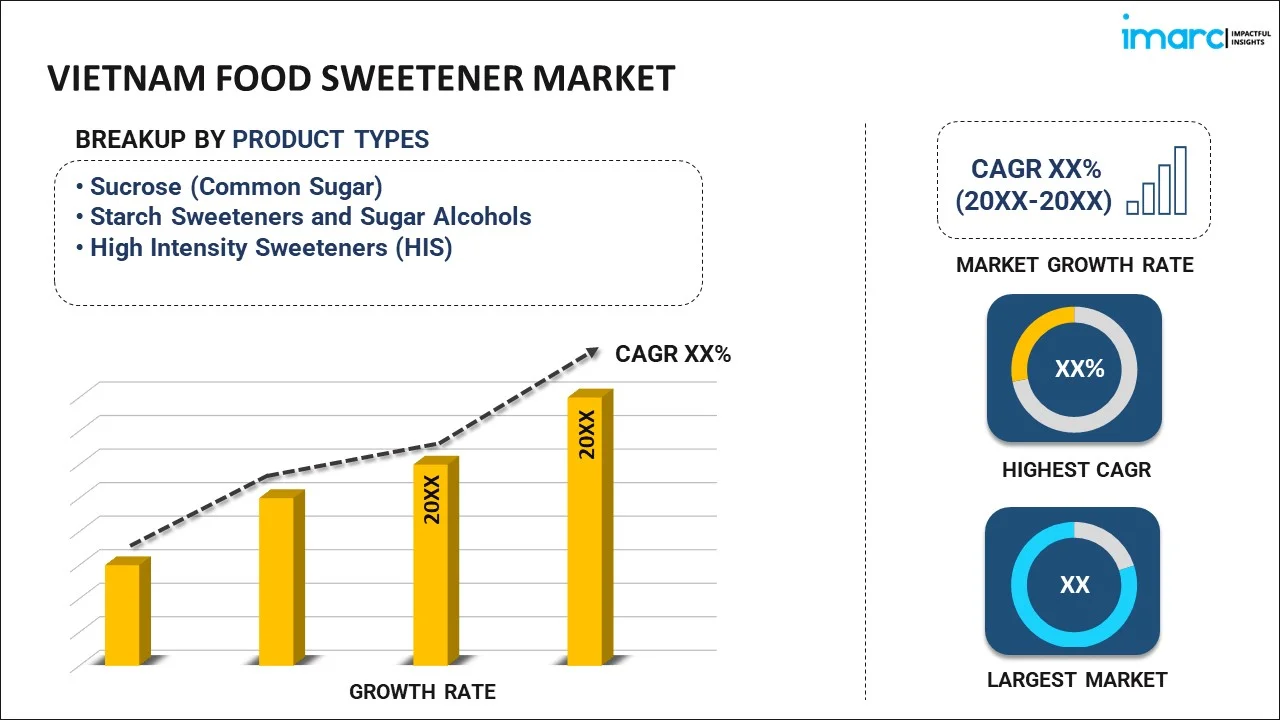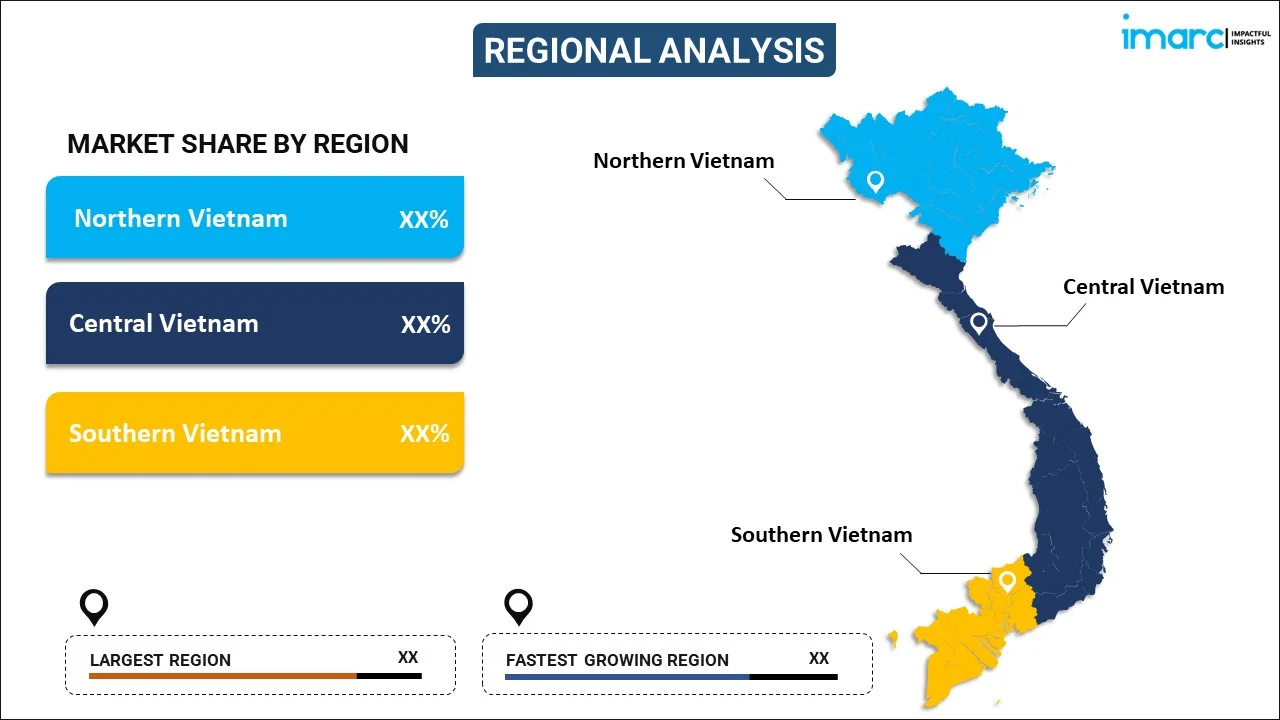
Vietnam Food Sweetener Market Report by Product Type (Sucrose (Common Sugar), Starch Sweeteners and Sugar Alcohols, High Intensity Sweeteners (HIS)), Application (Dairy, Bakery, Soups, Sauces and Dressings, Confectionery, Beverages, and Others), and Region 2025-2033
Market Overview:
Vietnam food sweetener market size reached USD 372.8 Million in 2024. Looking forward, IMARC Group expects the market to reach USD 455.3 Million by 2033, exhibiting a growth rate (CAGR) of 2.25% during 2025-2033. The rising health-consciousness among consumers, increasing awareness about sugar-related health issues, growing prevalence of health conditions, rapid expansion of the food and beverage industry, and inflating disposable incomes represent some of the key factors driving the market.
|
Report Attribute
|
Key Statistics
|
|---|---|
|
Base Year
|
2024 |
|
Forecast Years
|
2025-2033
|
|
Historical Years
|
2019-2024
|
| Market Size in 2024 | USD 372.8 Million |
| Market Forecast in 2033 | USD 455.3 Million |
| Market Growth Rate (2025-2033) | 2.25% |
Food sweeteners are substances used to enhance the sweetness of food and beverages. They come in various forms, including natural, artificial, and sugar substitutes, and serve the primary purpose of making products taste sweet without excessive sugar. Natural sweeteners like honey and maple syrup are derived from plant or animal sources and are minimally processed. Artificial sweeteners, like aspartame and saccharin, are chemically synthesized compounds that provide intense sweetness with little to no calories, making them suitable for people looking to reduce sugar intake. Sugar substitutes, such as stevia and erythritol, are often derived from plants and processed to provide a sweet taste without affecting blood sugar levels. Food sweeteners are used in various products, including soft drinks, baked goods, and candies, to add sweetness, enhance flavor, and reduce the overall sugar content. At present, food sweeteners are gaining immense traction across Vietnam as they play a crucial role in satisfying the cravings for the sweetness of consumers while addressing health concerns related to excessive sugar consumption, making them a significant component of the modern food industry.
Vietnam Food Sweetener Market Trends:
The Vietnam food sweetener market is experiencing significant growth, driven by the increasing health awareness among consumers that prompts a shift toward healthier dietary choices, including the preference for reduced-sugar or sugar-free products. As a result, there is a rising demand for sweeteners that provide sweetness without the caloric impact of sugar, thereby fueling market growth. Apart from this, the increasing prevalence of health conditions, such as diabetes and obesity, has augmented the need for alternative sweetening options that do not negatively affect blood sugar levels. In line with this, the escalating consumption of sugar substitutes and low-calorie sweeteners in various food and beverage products is propelling market growth. Additionally, the rapid expansion of the food and beverage industry in Vietnam and inflating disposable incomes have amplified the demand for sweeteners as manufacturers seek to meet consumer preferences for reduced sugar and healthier product options, supporting market growth. Along with this, the growing pursuit of weight management and reduced calorie intake has accelerated the adoption of low-calorie sweeteners in Vietnam's food industry. Besides this, the rising regulatory support and approval for various sweeteners has catalyzed market growth. Furthermore, the versatility of sweeteners that allows them to be used in a wide range of food and beverage applications is contributing to market growth. Other factors, including the growing desire for dental health and reduced risk of tooth decay, escalating demand for diverse flavor profiles in food and beverages, and increasing consumer awareness about the glycemic index and its impact on blood sugar levels, are also anticipated to stimulate market growth.
Vietnam Food Sweetener Market Segmentation:
IMARC Group provides an analysis of the key trends in each segment of the market, along with forecasts at the country level for 2025-2033. Our report has categorized the market based on product type and application.
Product Type Insights:

- Sucrose (Common Sugar)
- Starch Sweeteners and Sugar Alcohols
- Dextrose
- High Fructose Corn Syrup (HFCS)
- Maltodextrin
- Sorbitol
- Xylitol
- Others
- High Intensity Sweeteners (HIS)
- Sucralose
- Aspartame
- Saccharin
- Cyclamate
- Ace-K
- Neotame
- Stevia
- Others
The report has provided a detailed breakup and analysis of the market based on the product type. This includes sucrose (common sugar), starch sweeteners and sugar alcohols (dextrose, high fructose corn syrup (HFCS), maltodextrin, sorbitol, xylitol, and others), and high intensity sweeteners (HIS) (sucralose, aspartame, saccharin, cyclamate, ace-k, neotame, stevia, and others).
Application Insights:
- Dairy
- Bakery
- Soups, Sauces and Dressings
- Confectionery
- Beverages
- Others
A detailed breakup and analysis of the market based on the application have also been provided in the report. This includes dairy, bakery, soups, sauces and dressings, confectionery, beverages, others.
Regional Insights:

- Northern Vietnam
- Central Vietnam
- Southern Vietnam
The report has also provided a comprehensive analysis of all the major regional markets, which include Northern Vietnam, Central Vietnam, and Southern Vietnam.
Competitive Landscape:
The market research report has also provided a comprehensive analysis of the competitive landscape in the market. Competitive analysis such as market structure, key player positioning, top winning strategies, competitive dashboard, and company evaluation quadrant has been covered in the report. Also, detailed profiles of all major companies have been provided.
Vietnam Food Sweetener Market Report Coverage:
| Report Features | Details |
|---|---|
| Base Year of the Analysis | 2024 |
| Historical Period | 2019-2024 |
| Forecast Period | 2025-2033 |
| Units | Million USD |
| Scope of the Report | Exploration of Historical and Forecast Trends, Industry Catalysts and Challenges, Segment-Wise Historical and Predictive Market Assessment:
|
| Product Types Covered |
|
| Applications Covered | Dairy, Bakery, Soups, Sauces and Dressings, Confectionery, Beverages, Others |
| Regions Covered | Northern Vietnam, Central Vietnam, Southern Vietnam |
| Customization Scope | 10% Free Customization |
| Post-Sale Analyst Support | 10-12 Weeks |
| Delivery Format | PDF and Excel through Email (We can also provide the editable version of the report in PPT/Word format on special request) |
Key Questions Answered in This Report:
- How has the Vietnam food sweetener market performed so far and how will it perform in the coming years?
- What has been the impact of COVID-19 on the Vietnam food sweetener market?
- What is the breakup of the Vietnam food sweetener market on the basis of product type?
- What is the breakup of the Vietnam food sweetener market on the basis of application?
- What are the various stages in the value chain of the Vietnam food sweetener market?
- What are the key driving factors and challenges in the Vietnam food sweetener?
- What is the structure of the Vietnam food sweetener market and who are the key players?
- What is the degree of competition in the Vietnam food sweetener market?
Key Benefits for Stakeholders:
- IMARC’s industry report offers a comprehensive quantitative analysis of various market segments, historical and current market trends, market forecasts, and dynamics of the Vietnam food sweetener market from 2019-2033.
- The research report provides the latest information on the market drivers, challenges, and opportunities in the Vietnam food sweetener market.
- Porter's five forces analysis assist stakeholders in assessing the impact of new entrants, competitive rivalry, supplier power, buyer power, and the threat of substitution. It helps stakeholders to analyze the level of competition within the Vietnam food sweetener industry and its attractiveness.
- Competitive landscape allows stakeholders to understand their competitive environment and provides an insight into the current positions of key players in the market.
Need more help?
- Speak to our experienced analysts for insights on the current market scenarios.
- Include additional segments and countries to customize the report as per your requirement.
- Gain an unparalleled competitive advantage in your domain by understanding how to utilize the report and positively impacting your operations and revenue.
- For further assistance, please connect with our analysts.

 Inquire Before Buying
Inquire Before Buying
 Speak to an Analyst
Speak to an Analyst
 Request Brochure
Request Brochure
 Request Customization
Request Customization



.webp)




.webp)












